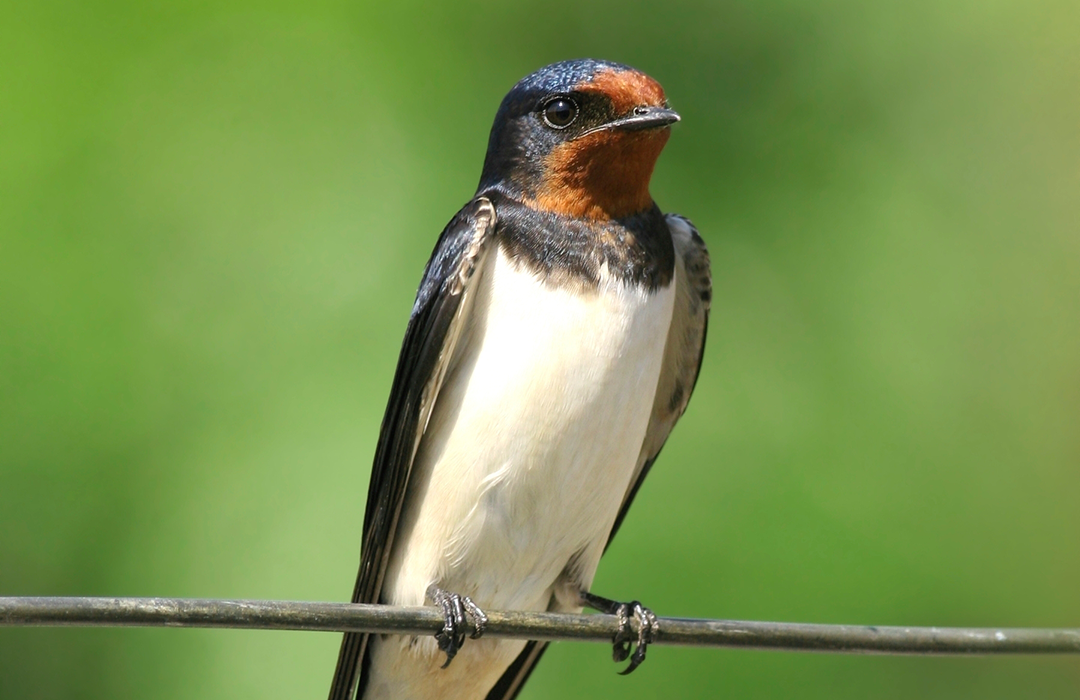The Barn Swallow
An exhausted swallow rests after its long migration from the wintering grounds in South America. Its journey may not be over; while the swallows have returned to southern Canada, the migration continues for those returning to areas further north. As you await your first sighting of these agile fliers, the following information may add to your anticipation.
Where do they live?
The Barn Swallow (Hirundo rustica) live in open habitats across Canada south of the treeline—in fields, parks, roadway edges, marshes, meadows, ponds, and coastal waters. It has become our neighbour, nesting under the eaves or inside sheds, barns, bridges and other structures.

What do they look like?
The Barn Swallow is a medium-sized songbird—15–19 cm in length and 17–20 g in weight—with steely blue back, wings (29–32 cm wingspan) and tail, and rufous to tawny underparts. The blue crown and face contrast with the cinnamon-colored forehead and throat. Males are more boldly colored than females.
What do they eat?
Barn Swallows forage and feed on the fly—literally! They eat a variety of flying insects, especially flies (including houseflies and horse flies), beetles, wasps, wild bees, winged ants, and true bugs. They also feed on moths, damselflies, grasshoppers, and other insects, and a few spiders and snails, and occasionally eat a few berries or seeds.
How do they reproduce?
They are usually monogamous during the breeding season, but extra-pair copulations are common, and new pairs form each spring. Polygyny sometimes occurs. Both members of the pair build the nest, incubate the 3–7 eggs for 12–17 days, and feed the young. The young leave the nest 17–24 days after hatching. There may be one or two broods per year.

Barn vs. Cliff Swallow?
These two species are very similar in appearance. Here are some tips to help in identification:
- The Barn Swallow has a slimmer body and a deeply forked tail; the Cliff Swallow is stockier and has a squared tail.
- When foraging together, the Barn Swallow skims closer to the ground or water; the Cliff Swallow flies much higher.
- While several Barn Swallows may nest near each other, they do not form dense colonies like the Cliff Swallows.
- Barn Swallows create a long, heavy, vertical nest, built of mud pellets. By contrast, the Cliff Swallow mud nest is shaped like a hollow gourd, with a hole for the parents to enter and the young to look out.
More stuff
- Although the Barn Swallow is the most abundant and widely distributed swallow species in the world, its population has declined in Canada since 1970. In 2011, the Committee on the Status of Endangered Wildlife in Canada listed the Barn Swallow as threatened. In 2012, Ontario added the Barn Swallow to their threatened list. Since these assessments, several initiatives have sought to reverse the decline in Barn Swallow population through habitat improvement and access to nesting sites.
- Older siblings help build the nest, incubate the eggs, and guard the young, although they generally do not feed the young.
- Barn Swallows can survive up to 11 years, but rarely live more than 4 years.
The spectacle of the Barn Swallow as it turns and twists in pursuit of flying insects is one of bird lovers’ favourite sights of the season. It is a bird however that has a declining population.
Subscribe for updates to stay up to date on what Nature Canada is doing to support birds in Canada!



